BIOSCIENCE Pharmacological studies
Studies for allergies
- Expertise in studies for allergies
- *The following descriptions are all based on the expertise obtained through the studies experienced in KAC and may differ from data in other institutes.
Skin itch test (scratching behavior test)
- [Selection of animal species]
- In general, mice are often used in "studies on scratching behavior in the back by the hind limb in experimental animals." We attempted a study in rats that resulted in an overwhelmingly lower trend in the number of scratching behaviors than in the mouse studies (see the charts below).
Based on this result, the mouse is better than the rat as an animal species to be used.
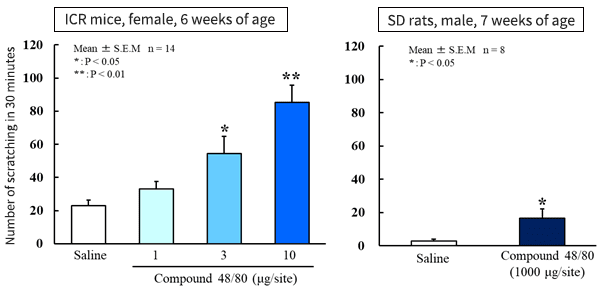
- [Selection of mouse strain]
- (1) Using a scratching behavior-inducing substance
ICR mouse strain is useful when using a scratching behavior-inducing substance (e.g., Compound 48/80, serotonin, histamine and substance P). ICR mice tend to exhibit more frequent scratching than other mouse strains. Furthermore, histamine-induced scratching behavior is difficult to induce in mouse strains other than ICR mice.
(Reference: Skin Pharmacol Appl Skin Physiol. Mar-Apr 2001;14(2):87-96, N Inagaki, Scratching behavior in various strains of mice)
(2) Using sensitization
BALB/c mice are generally used in systemic sensitization using ovalbumin (hereinafter OVA) or studies using hapten. Note that allergic symptoms may be induced differently by breeder even within the BALB/c mice. This is also the case in chronic dermatitis model using NC mice described later.
- [Sex of mice]
- Many behavioral pharmacological studies use male mice more often because variation in behavior due to sexual cycle in females is unwanted. On the other hand, some literature on skin pruritus studies or skin allergy studies used female mice. That was possibly because male mice have a higher risk of injury in the back or auricle through fighting when they are housed in a group.
In single cage housing, male mice can be used without problem. In our experience, the number of scratching behaviors and severity of dermatitis show no marked difference between males and females.
- [Scratching behavior observation cage]
- Cages to contain mice for observation of scratching behavior (observation cage) should also be selected carefully.
A certain percentage of mice try to jump and escape from the cage. Therefore, in a low cage such as housing cages, they will escape or climb up the wall. However, if the cage is covered by metal mesh, etc., to prevent that, they will hang from the mesh making it difficult to cause scratching.
KAC uses specially-ordered observation cages that are made to meet the following conditions:
(1) Walls high enough to prevent mice from escaping (impossible to climb up)
(2) Heavy enough to be immobile even if mice are violent
(3) A shape where feces and urine can be washed away easily



Each observation cage has a capacity for up to 4 mice, which are videotaped from directly above for counting the number of scratching behaviors in the video footage.


- [Scratching behavior]
- KAC assesses scratching behavior depending on the type of allergy model.
- Skin allergy (pruritus) model
(1) Scratching of the back by the hind limb
⇒Studies using a pruritus-inducing substance
(2) Scratching of the auricle by the hind limb
⇒Hapten challenge, NC mouse test
(3) Scratching of the auricle by the forelimb
⇒ NC mouse test - Nasal allergy study
Nasal Rubbing by the forelimb - Chronic conjunctivitis study
Scratching of the eye by the hind limb
In the above scratching, each scratching behavior by the hind limb is counted when "raising the hind limb for scratching, scratching and then lowering back the hind limb" (not counted as the number of strokes). Each scratching behavior by the forelimb is counted as "each stroke of scratching by the forelimb."
- [Pruritus test by an inducing substance]
- A pruritus-inducing substance is selected depending on the mechanism of action of the test article to be assessed for efficacy.
Pruritus due to allergy: Compound 48/80, histamine, haptens
Central nervous pruritus: Substance P
Pruritus-inducing substances are intradermally administered to the mice in the rostral back (the site marked x on the right figure).
- A 30G needle is used to administer at 20 μL/site with a glass syringe.
- Assessment with administering the pruritus-inducing substance immediately after introducing inhalation anesthesia is also possible in conditions such as intracerebroventricular administration of the test article (a control group will be essential, where control substance is administered immediately after introducing inhalation anesthesia in the same condition). If there is a concern about scratching-like behaviors after awaking from anesthesia, the inducing substance may be administered 5 minutes after introducing inhalation anesthesia.
- If an ointment or cream is used as the test article, it can be assessed in a comparative manner by applying similar vehicle control. Basically, while application alone induces scratching (-like behaviors), scratching behaviors due to the inducing substance are exhibited obviously in addition to this.

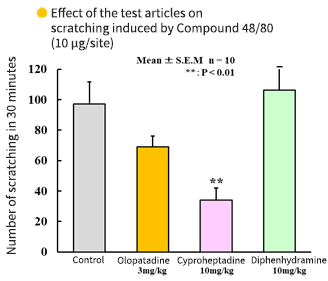
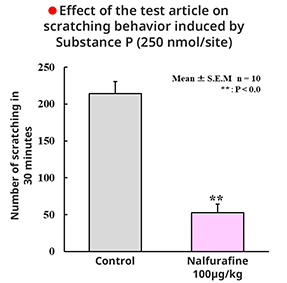
Chronic dermatitis studies in NC mice

- [NC mouse]
- The NC mouse (NC/Nga mice) is said to present no symptoms under SPF rearing condition but develops atopic dermatitis-like skin symptoms spontaneously in a conventional animal housing facility. In actual settings, however, they develop no symptoms only by keeping them in a conventional environment at the usual level.
NC mice are known to exhibit spontaneous-onset atopic dermatitis-like skin symptoms in response to mites. In this case, a conventional environment means "an environment with mites."
Thus, animal breeders market "NC mice with mites," which spontaneously develop dermatitis after purchasing and keeping them in the usual setting.
However, these "NC mice with mites" have the following problems:
(i) Facilities keeping animals for multiple clients like KAC cannot keep animals with mites.
(ii) The spontaneous onset model often develops fulminant dermatitis, with alopecia affecting most of the dorsal hair coat, crusting and bleeding in the skin and tearing in the auricles. Therefore, the model tends to be incapable of assessing effects unless the test article is strong.
- [Mite antigen-induced chronic dermatitis model]
- KAC induces atopic dermatitis-like pathology by administering mite antigen in the auricular skin of NC mice.
The severity of dermatitis is assessed in (i) auricular thickness and (ii) auricular skin symptom score.


- Skin symptom score
The following 4 skin symptoms are scored from none (0), mild (1), moderate (2) and severe (3).
1) Redness/flush
1: Redness along the vessels
2: Redness spreading from the vessels
3: Redness occupying one-half or more of the auricular area.
2) Bleeding/clots
1: One or 2 spots of bleeding/clots
2: Three or more spots of bleeding/clots or bleeding/clot areas
3: Bleeding/clots occupying one-half or more of the auricular area.
3) Crust/excoriation
1: One or 2 spots of crust/excoriation
2: Three or more spots of crust/excoriation or crust/excoriation areas
3: Crust/excoriation occupying one-half or more of the auricular area.
4) Induration (severity of induration is assessed by slowly bending the auricle with the fingers)
1: Can be bent with feeling a core
2: Some hardened portion cannot be bent
3: Induration occupying one-half or more of the auricular area.
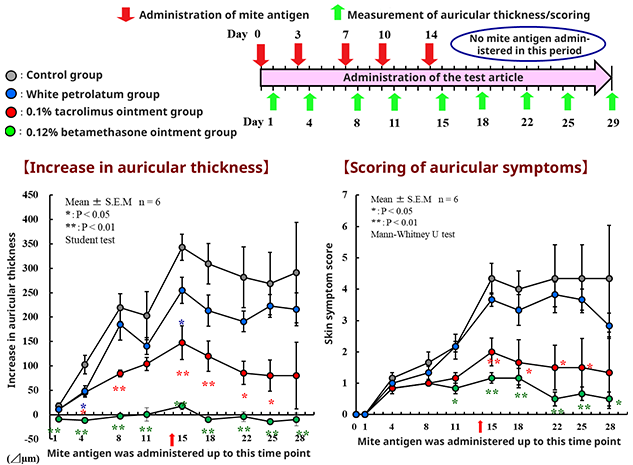
- [Pruritus assessment in mite antigen-induced chronic dermatitis models]
- In chronic dermatitis models in NC mice, scratching behavior does not start immediately after administration of mite antigen or end after a while, contrary to scratching behavior induced by pruritus-inducing substance.
In observations after administration of mite antigen, while scratching of the site of mite antigen administration (auricle) by the hind limb was rarely observed, signs of scratching behavior such as crust, excoriation, bleeding and clots were observed. That is to say, scratching behavior occurs and definitely is a factor for exacerbation of skin symptoms.
To assess scratching behavior in the auricle in NC mice, the following 2 points are important:
(i) Assessing not only the number of scratching behaviors by the hind limb but also by the forelimb.
(ii) Measurement should be performed for a long time (3 hours or more) because measurement in one hour often fails to find any difference.

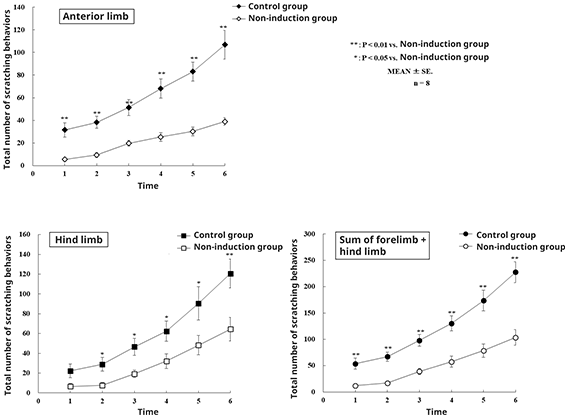
No significant difference was observed in the number of scratching behaviors in an hour only by the hind limb between the non-induction group and control group but in the number of scratching behaviors in an hour by the forelimb and sum of forelimb + hind limb.
Next, the test article was administered on Day 15 in a condition similar to the above to assess its suppressive effect on scratching behavior in NC mice.
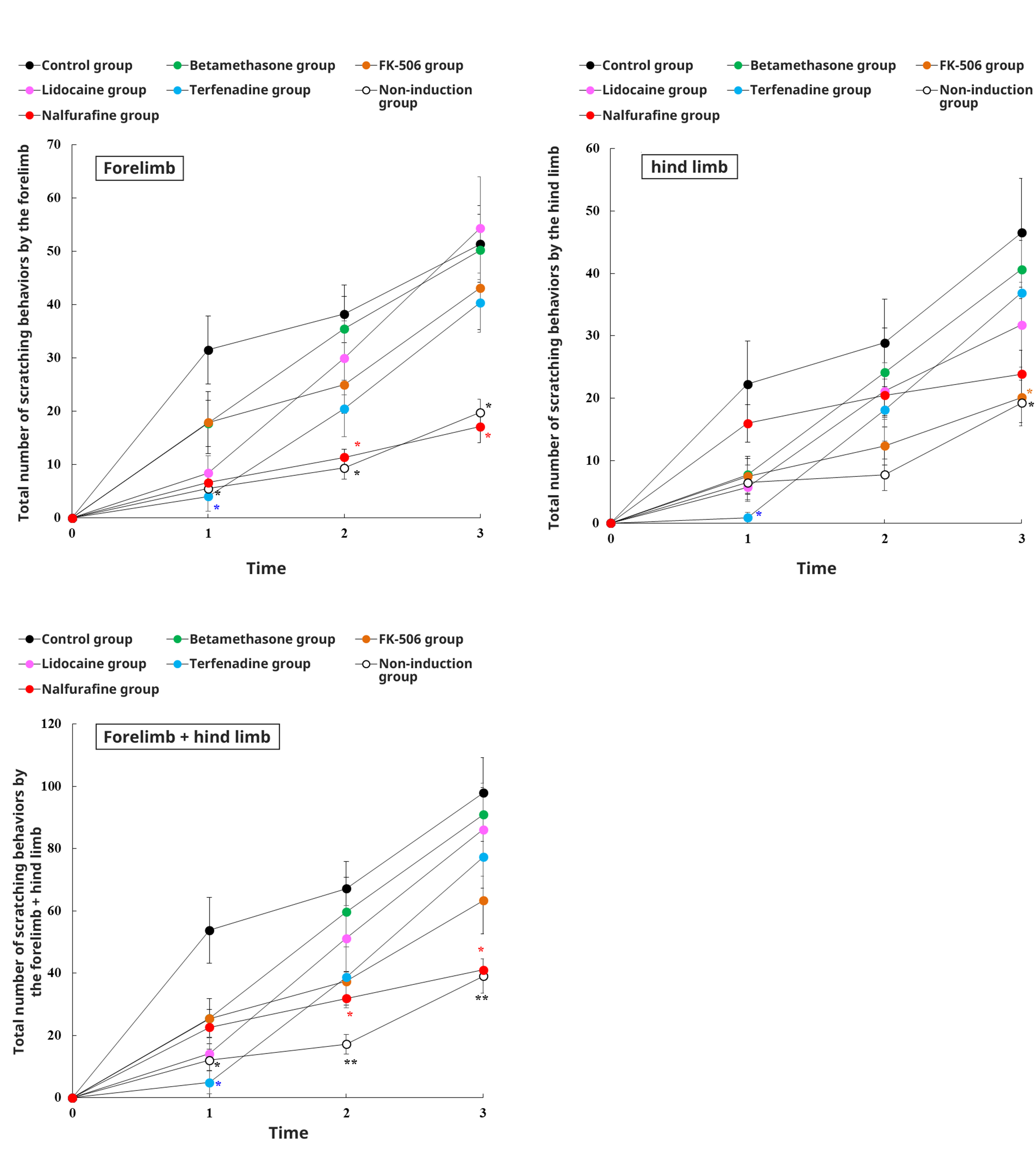
In this study, nalfurafine had a significant suppressive effect on scratching behavior continuously throughout the 3-hour measurement period, while it did not suppress auricular thickness or skin symptom score.
Betamethasone significantly suppressed auricular thickness and skin symptom score but did not suppress scratching behavior. FK-506 (tacrolimus) suppressed auricular thickness, skin symptom score and scratching behavior all with statistical significance.
[ close ]
